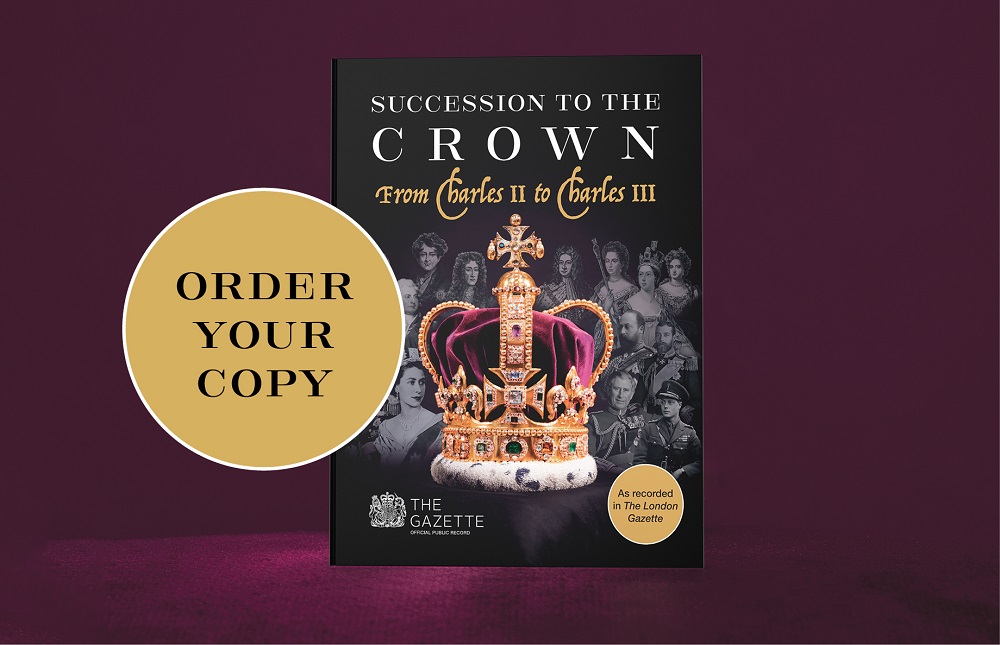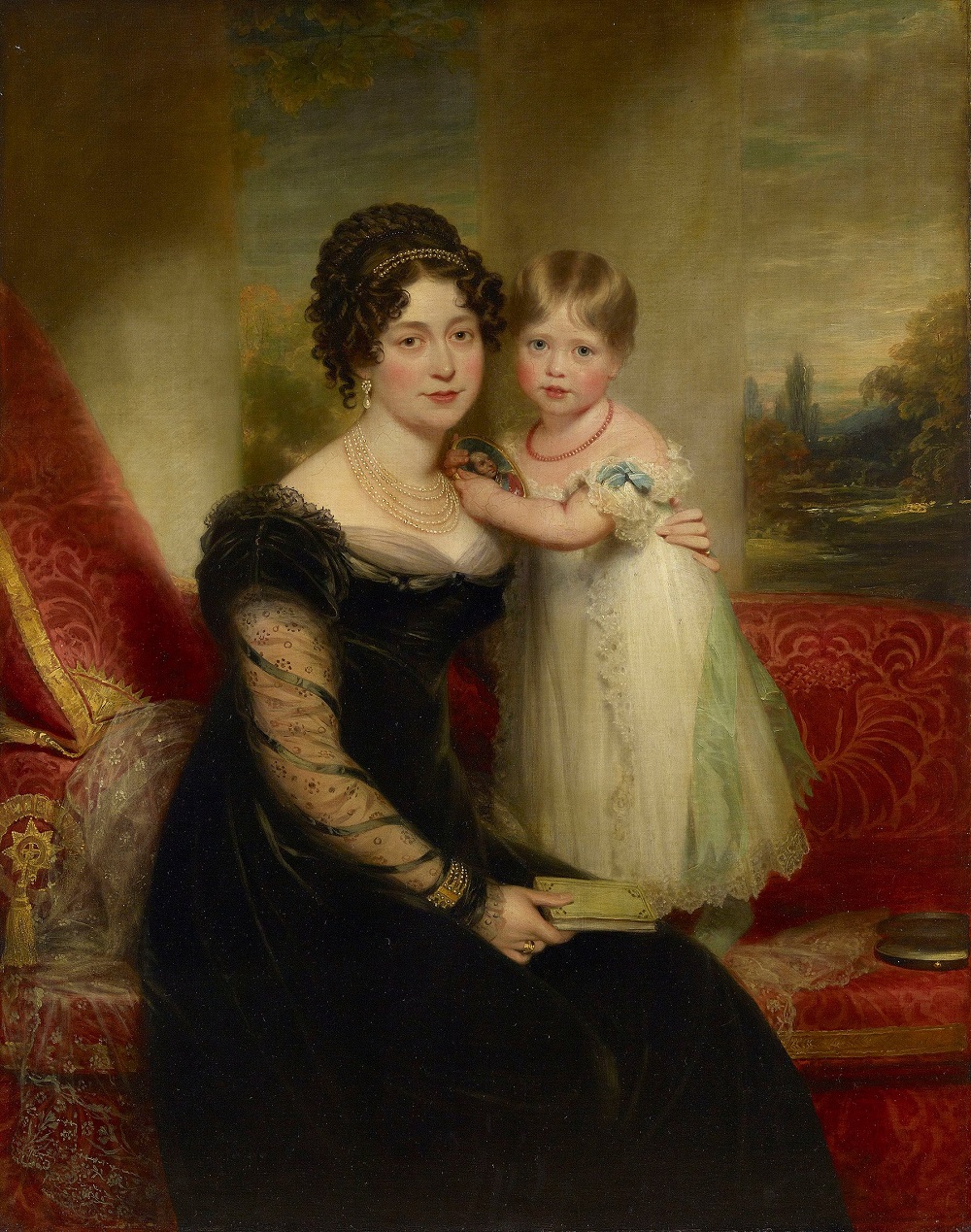Succession to the Crown: King William IV

As the official public record since 1665, The Gazette has been recording successions to the Crown for over three centuries. As part of our Succession to the Crown series, historian Russell Malloch looks through the archives at the accession and reign of King William IV, as described in The Gazette.
Chapters
Succession to the Crown paperback

To celebrate the new king’s coronation, The Gazette’s Succession to the Crown series has been released in paperback.
Available to order now from the TSO Shop, the Succession to the Crown paperback explores the coronations, honours and emblems of the British monarchy, and includes an exclusive chapter on the accession of King Charles III.
Find out more in the link below.

Accession Council
The last of the five Accession Councils for the House of Hanover was held at St James’s Palace after King George IV expired in the early hours of Saturday 26 June 1830 (Gazette issue 18696), when those present declared that the imperial crown had come to “the high and mighty Prince William Henry, Duke of Clarence and St Andrews, and Earl of Munster”, who now became King William IV.
The London Gazette published the proclamation from that historic council (Gazette issue 18698), which was attended by the King’s brothers Ernest and Augustus, and by an unusually large group of lords spiritual, including the archbishops of Canterbury and York and several bishops, while the Duke of Wellington appeared as prime minister, and the city of London continued to be well represented.
The King made a short declaration about passing his life in the service of the country, which was a reference to his role in the Royal Navy, as well as his endeavours to maintain the reformed religion established by law, and to promote the prosperity and happiness “of all classes of my people.” He also reflected on the growth in the Crown’s overseas interests, as he returned to the theme of the 1727 Accession Council and acknowledged his duty “to administer the government of this great empire”.
There had been many additions to that empire since the days of George II, as evidenced by the fact that The Gazette recorded that William nominated governors to represent the Crown in colonies such as Ceylon and Mauritius, Canada and British Guiana, and New South Wales and St Helena. The King’s imperial legacy was not reflected in any addition to his titles, and no honours were created for any of the Crown’s other overseas interests, following the precedent of the Order of St Michael and St George, whose remit covered no more than a few Mediterranean islands.
Overseas interests
As was the case ten years earlier, the Accession Council did not mention the King’s German domains but the banners of Brunswick and Hanover were carried beside those of England, Scotland and Ireland at the late King’s funeral in St George’s Chapel on 15 July 1830, and the crown of Hanover was once again carried by the secretary of the Guelphic Order (Gazette issue 18707).
King William did not visit Hanover after his coronation as his brother had done in 1821, and he never left England, with the result that there was no need for the royal authority to be delegated to Queen Adelaide or to any other person on account of his absence from the realm.

FitzClarence family
In some respects, the succession was more interesting during William’s reign than it had been since 1714, when it became clear that Queen Anne would have no surviving children, and that the throne would therefore pass from the House of Stewart to Princess Sophia, or a member of her German family.
The King’s daughters by Queen Adelaide had died young, but he had several surviving children by Mrs Jordan who were unable to inherit the throne. It was therefore likely that William would be followed by his niece, Princess Victoria of Kent, and in December 1830 assent was given to an act to provide for the administration of the royal authority in case she should come to the throne under the age of 18 years (Gazette issue 18762).
The 1830 act contemplated that the Duchess of Kent, rather than one of the King’s surviving brothers, would act as regent on her daughter’s behalf, but without any council of the kind that was provided for in the earlier regency acts. In practice, the 1830 statute, like the earlier acts, was never required as Victoria lived to celebrate her 18th birthday in May 1837.
The King’s children were not neglected, and special provision was made for Princess Victoria’s cousins, who used the surname FitzClarence in recollection of their father’s title of Duke of Clarence. A few months after the passing of the Regency Act a series of royal favours were conferred on the FitzClarence family after their father ascended the throne, as The Gazette of May 1831 reported that the King’s eldest son, Colonel George FitzClarence, had been granted the dignities of baron Tewkesbury, viscount FitzClarence and Earl of Munster (one of the King’s subsidiary titles before he came to the throne) (Gazette issue 18803).
Less than a fortnight later it was announced that William’s younger sons, Frederick, Adolphus and Augustus FitzClarence had been granted the title and precedence of the younger sons of a marquess, which allowed them to use the prefix “Lord”, while three of his daughters – Sophia Sidney, Mary Fox and Augusta Erskine – were given the precedence of the daughters of a marquess.
Honours system
King William made no major additions to the honours system, beyond approving a medal that was intended to mark long service and good conduct in the army. The medal was established in July 1830 and was to display “the King’s arms”, and so was the first medal to be worn by soldiers that carried the royal arms, which were shown in an oval shield placed against a background of military trophies.
The use of royal emblems in the design of such medals would have implications for the future, and in particular give rise to questions in connection with a succession to the Crown, where there may (or may not) be changes to the royal emblems that were appropriate to the new sovereign.
Towards the end of William’s reign there was an extension of the “colonial honours” concept, as the governor-general in India established the Order of British India that could be granted to army personnel for “long, faithful and honourable service”, and the Order of Merit as a reward for personal bravery. These honours retained their local character until the early part of the 20th century and ceased to be awarded after India gained its independence in the 1940s.

The coronation on 8 September 1831 was marked by the award of several honours, and by the customary “throwing about” of coronation medals, which showed the King’s effigy on one side, and Queen Adelaide on the other.
William sanctioned some limited changes to the orders, for example by fixing the number of ordinary knights of St Patrick at 22 rather than the original figure of 15, and by extending the ceremonial life of members of the orders, through arranging meetings to be held at which the appointment of members was confirmed, and holding state dinners for knights.
The Gazette reflected a new approach to the Order of St Patrick. The Irish noblemen had usually received their insignia from the lord lieutenant in Dublin, but in October 1831 the King attended a chapter at St James’s Palace and invested two peers who were nominated as extra knights at the time of his coronation (Gazette issue 18863). Similar investitures were held in England in March 1833 for the Marquess Conyngham (the son of King George IV’s last mistress), and in July 1835, in the presence of the archbishops of Armagh and Dublin, the King knighted and invested the order’s usher and presented a knight’s insignia to the Earl of Cork (Gazette issue 19291).
The Gazette reported the ceremonial for many of the royal investitures but not the knights’ banquets. Although the special Gazette of 8 May 1837, which announced the death of the Queen’s mother, explained that the Garter banquet planned for 13 May would be postponed until further notice, as would later banquets for the Thistle, Bath and St Patrick (Gazette issue 19492). In fact none of the knights were entertained by the King, as he died one month after his mother-in-law.
The final honours of the Hanoverian era, which began in 1714 when Captain William Saunderson was knighted after he carried the Elector to England, were gazetted on 6 June 1837, when it was announced that Major-General William Johnston had become a knight commander of the Bath, and that Simon Heward would be made a knight bachelor (Gazette issue 19502).
Heward’s patent was to be passed under the great seal that was prepared after William’s accession, which was the last to show the Hanoverian coat of arms. The design reflected the King’s naval interests, as it placed the figure of Neptune at the King’s side, while the counterseal displayed the King on horseback, but with two ships rather than a battlefield in the background.

Succession
When the King died on 20 June 1837 (Gazette issue 19509) the law obliged his eldest son, by now the Earl of Munster, to give way to his cousin Princess Victoria as sovereign of the United Kingdom, and the earl was also unable to succeed to his father’s crown of Hanover, which could not pass to a woman and so devolved on his uncle Ernest, Duke of Cumberland.
The personal union of the crowns that was forged when the Elector of Hanover succeeded Queen Anne now came to an end, and The Gazette reflected the sovereign’s German interests for the last time in connection with King William’s funeral, as the banners of Brunswick and Hanover were included in the procession in St George’s Chapel on 8 July 1837, and the crown of Hanover was carried for the final time by an official from the Hanoverian Legation (Gazette issue 19519).
About the author
Russell Malloch is a member of the Orders and Medals Research Society and an authority on British honours.
Let us know what you think of this article by getting in touch. All feedback is welcome.
See also
Gazette Firsts: The history of The Gazette and royal coronations
The Demise of Queen Elizabeth II and Accession of King Charles III
Queen Elizabeth II - In Memoriam
Images (in order of appearance)
The Gazette
Royal Collection Trust / © His Majesty King Charles III 2022
Royal Collection Trust / © His Majesty King Charles III 2022
Noonans of Mayfair
Getty Images
Publication date: 2 December 2022
Any opinion expressed in this article is that of the author and the author alone, and does not necessarily represent that of The Gazette.
